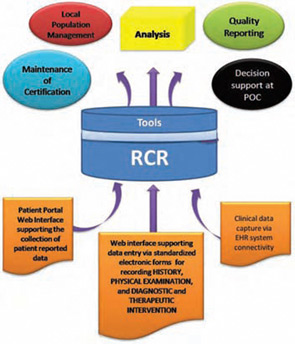Rheumatologists practicing in the current healthcare environment are experiencing unprecedented information flow, data management issues, and a rise in quality designations and pay-for-performance incentive programs. There is increasing pressure on rheumatologists to document or capture treatment concordance with guideline recommendations and best practices and to monitor gaps in care and patient outcomes. Unfortunately, some quality programs are not considered clinically meaningful, and even those that are often bring administrative burdens related to reporting, data aggregation, and analysis.
Electronic systems provide the opportunity for rheumatology practices to systematically store patient information in a way that can be easily accessed, filtered, and analyzed. Local systems that store patient data may be comprehensive electronic health records (EHRs) or more limited specific data storage applications called electronic patient registries (or chronic disease management systems). Either way, well-designed systems can provide the data that reveal opportunities for improvement in care delivery, clinical and administrative processes, outcomes, and patient satisfaction.
What Do I Do With All This Data?
The healthcare system is brimming with patient information. For the average rheumatology practice, the challenge lies in knowing how to successfully aggregate information from different sources, organize and store the information, and process it in a way that yields useful and actionable knowledge. Electronic patient registry systems can help your practice manage information in a structured, effective, and efficient way; they can also identify areas for improvement.
An electronic patient registry is a computer application that gathers, stores, and processes large amounts of disease-specific individual and population-based health information. The application effectively extracts and transforms those data into actionable knowledge that supports care management, outreach, quality improvement, and outcome research.
An electronic registry supports organized care management by:
- Generating patient-specific reports on services performed;
- Generating condition-specific care prompts and recommendations;
- Offering outreach support that identifies patients who have missed appointments, are due for services, or who are not reaching care goals; and
- Promoting the timely availability of evidence-based health information to meet patients’ specific needs and support sound clinical decision making.
A good electronic registry will generate patient population-level reports for your practice and stratify them as needed. These reports can be run and tracked over time to provide performance feedback to care teams.
Using an Electronic Registry
When fully integrated into practice operations, an electronic registry system will allow for complete utilization of one of the practice’s most valuable assets: patient data. A successfully implemented registry system will also give your practice the ability to take the reins in performing analyses for strategic decision making. Your practice will be empowered to stay one step ahead of the ever-changing healthcare environment, especially as it relates to patient safety and reimbursement issues.
